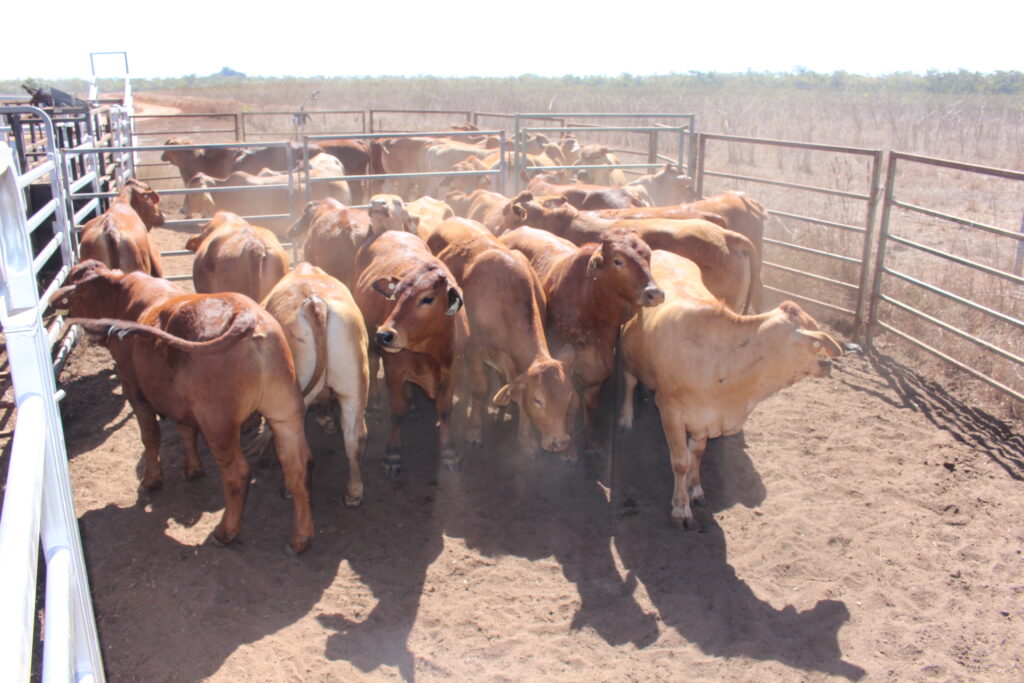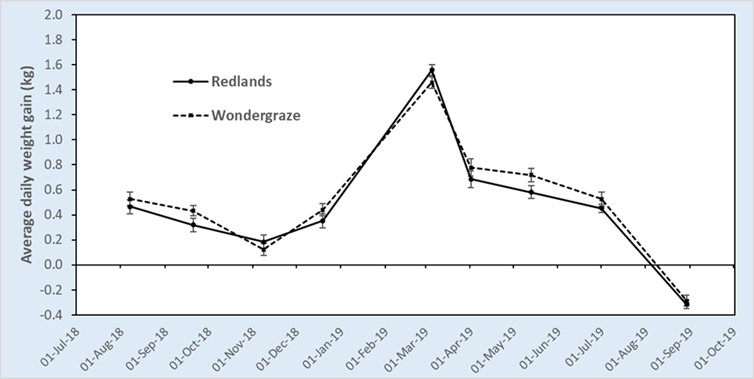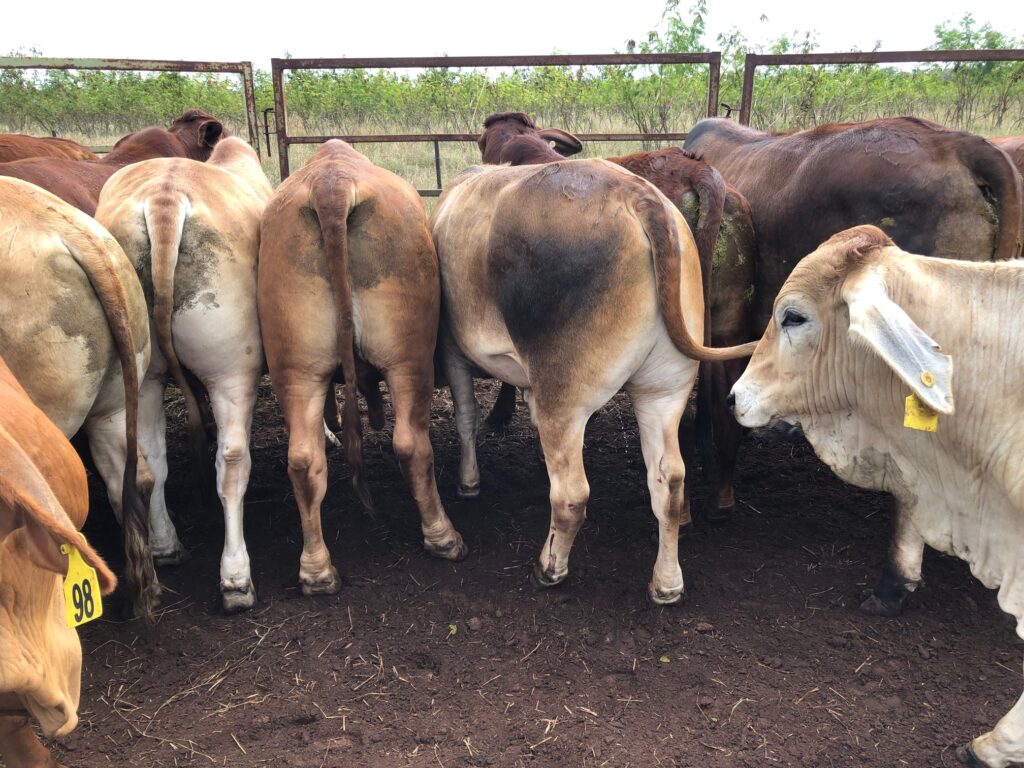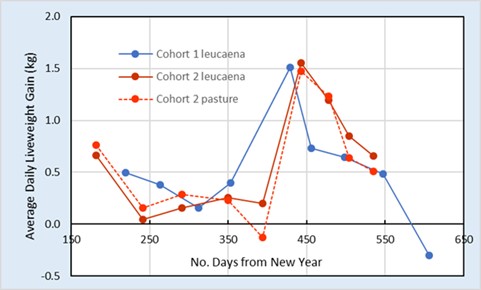Assessing productivity gains for cattle grazing “Redlands” (R12) leucaena in northern Queensland
Introduction
Leucaena pastures in northern Australia regularly incur production losses from attacks by leucaena psyllids (Heteropsylla cubana). Psyllids are sap-suckers which mainly feed on new leaf – they can defoliate trees, reduce acceptability to cattle and limit plant growth. Attacks vary with seasons, but psyllids prefer warm-moist conditions, which are typical of coastal and sub-coastal areas of northern Queensland. All leucaena varieties previously used by industry are susceptible to psyllids. Redlands is a new leucaena variety with genetic resistance to psyllids It was released in 2018 and has potential to open-up new areas for leucaena-based grazing. However, the performance of Redlands under commercial grazing was untested. Also, in a 2015 palatability trial conducted at Whitewater (Mt Surprise district), cattle initially selected other leucaena varieties in preference to Redlands. This raised some doubts to the suitability of Redlands for commercial use.
To address these concerns, this project was established to compare the productivity of Redlands with an existing commercial leucaena variety under commercial scale grazing. In Phase I of the project, a 61 ha replicated trial site was developed at Pinnarendi, south-west of Mt Garnet in north Queensland. Half the site was planted with Redlands and the other half planted with the industry standard Wondergraze variety. A neighbouring 25 ha paddock, improved with buffel grass and stylo (no leucaena), has also been incorporated into the trial for comparison.
The grazing stage of the project (Phase 2) is underway. Successive cohorts of weaner steers are being grazed on the trial for a minimum of 365 days. Liveweight of animals is monitored at 6-8 week intervals.
Phase 1 – Site development and leucaena establishment
Pinnarendi has a seasonally wet-dry climate, with an average annual rainfall of about 750 mm, mostly from December to April. Elevation is about 750 metres above sea level with frosts occurring in some years. The site is about 95 km from the coast and psyllids were known to attack leucaena at nearby Meadowbank (to the east) and Whitewater (to the west). The soils are infertile, red-earths with relatively low moisture holding capacity. These soils would not be the first-choice for leucaena development, but they are well-drained, relatively uniform and representative of similar sites available for leucaena adoption in the north.
The trial site was used for cropping during the 1990s, but more recently had been given over to grazing. Preparation for the leucaena planting was started in late 2016. Planting strips 5 m wide were cultivated at 10 m centres with offset discs in October and December. The existing inter-row pasture was retained between strips and comprised mainly Indian couch (Bothriochloa pertusa), Wynn cassia (Chamaecrista rotundifolia), Sabi grass (Urochloa mosambicensis), Black Spear grass (Heteropogon contortus) and Stylosanthes spp.
Leucaena was planted over five days in late January 2017 with Wondergraze planted initially, followed by Redlands. There was a 30 mm fall of rain between the Wondergraze and Redlands plantings. Germination was satisfactory but patchy in areas. To improve uniformity, a follow-up planting was made in most paddocks about 1-month later. Rain in late May 2017 extended leucaena growth and development into the early dry season.
Soil testing was conducted across the site prior to development. In the top 10 cm of the profile, P and S averaged 5 and 3 ppm respectively. Applications of superphosphate and granulated S were made to the planting rows before and after planting. Superphosphate was also applied to the inter-row pasture in August 2017, after the leucaena was well established.
Psyllids were active at the site from May to September 2017 and a monitoring program showed significantly increased damage within Wondergraze paddocks. Eighty millimetres of storm rain was received in late October 2017, ensuring survival of leucaena. Once leucaena establishment was assured, internal fencing, water points and portable yards were installed.
Phase 2 – Grazing trial
1st Cohort
Cattle were first introduced into the trial in April 2018. Formalised grazing commenced in late June 2018 with rotation between paddocks and regular weighing. The 1st cohort comprised 28 Brahman-cross and Droughtmaster steers with an average entry weight of 206 kg. Over 368 days (28 June 2018 to 1 July 2019) there was no significant difference in average daily liveweight gain (ADG) between the cattle grazing Wondergraze (0.68 kg) and the cattle grazing Redlands (0.65 kg).


2nd Cohort
A 2nd cohort of 14 Brahman-cross steers with an average entry weight of 213 kg were introduced to the trial in April 2019 (overlapped with the 1st cohort) and remained on the trial until June 2020. At the same time, an additional 12 head from the same source (also with an average entry weight of 213 kg) were introduced to the neighbouring improved pasture paddock. Dry conditions during the second half of 2019 prevented the addition of more animals to the leucaena paddocks. Over 372 days (13 May 2019 to 19 May 2020) the ADG for the leucaena animals was 0.55 kg for both Redlands and Wondergraze. For the same period, the ADG for animals in the improved pasture was 0.54 kg.
Details of these two grazing cohorts, including stocking rates and annualised weight gains, are given in the Table below.

Table 1: Performance of two cohorts of weaner steers at the Pinnarendi leucaena liveweight gain trial
| Cohort and grazing period | Grazing treatment | No. of head | Average weight (kg) | Average daily gain (kg/day) | Annualised weight gain (kg) | Stocking rate (AE/ha) | |
|---|---|---|---|---|---|---|---|
| At start of period | At end of period | ||||||
| 1st Cohort 28 Jun 2018 - 1 Jul 2019 (368 days) | Wondergraze | 14 | 232 | 482 | 0.68 | 247 | 0.4 |
| Redlands | 14 | 226 | 465 | 0.65 | 238 | 0.39 | |
| 2nd Cohort 13 May 2019 - 19 Jun 2020 (403 days) | Wondergraze | 7 | 267 | 488 | 0.55 | 201 | 0.34 |
| Redlands | 7 | 257 | 486 | 0.57 | 208 | 0.33 | |
| Buffel/Stylo | 12 | 269 | 487 | 0.54 | 197 | 0.4 | |
3rd Cohort
A 3rd cohort of cattle has now replaced the 2nd cohort animals. There are 62 head in total with an average entry weight of 195 kg. They comprise 27 Brahman-cross steers introduced in April 2020 (26 on leucaena and 1 on improved pasture) and 25 Droughtmaster steers introduced in June 2020 (16 on leucaenea and 9 on improved pasture). The trial is now fully stocked and replicated. The intention is for the trial to be continuously grazed by these animals until about July 2021.
Findings and discussion
Redlands versus Wondergraze
Reassuringly, there has been no significant difference in liveweight performance for steers grazing Redlands or Wondergraze. Redlands has been readily accepted by cattle naïve to leucaena and is well-eaten at all times of the year. Paddocks of Wondergraze at the site had better initial germination and development compared to Redlands and are now more uniformly established as a result. This is attributed to conditions at planting rather than an inherent characteristic of Redlands and there has been excellent plantings of Redlands established by commercial producers at other sites in north Queensland in the meantime.
Whilst Wondergraze paddocks are superior to Redlands paddocks at the site, this has not yet resulted in significantly higher liveweight gains as might be expected. Possible reasons for this are:
-
- Only a relatively low amount of leucaena in the diet of animals is required to improve liveweight gains, particularly at times of year when pasture quality is otherwise low
- Applied fertiliser has boosted inter-row pasture productivity to the extent it has supressed the relative contribution being made by leucaena.
Psyllids
Psyllids have not been substantially active at the site since the establishment phase prior to grazing. As a result, conditions haven’t been experienced where Redlands would be expected to have a productivity advantage over Wondergraze. With a La Nina weather phase now declared, it is hoped that conditions at the site will be more favourable to psyllid activity during 2021.
Sub-optimal leucaena growth
Towards the end of the 2017-18 wet-season, leucaena over much of the site had poor colour (yellow leaf) and sub-optimal growth. Investigations indicated the cause as nitrogen deficiency from poor root colonization with rhizobium bacteria resulting from non-viable inoculant used at sowing. A remedial application of a custom blended fertiliser containing nitrogen was made to the leucaena rows. Leucaena growth remained sub-optimal over subsequent wet-seasons although there appears to be a gradual improvement.
Performance from improved pasture
In the first year of grazing in the improved pasture paddock, liveweight gains were similar to those achieved for animals on leucaena. This was somewhat surprising since it was expected the leucaena would significantly outperform the improved pasture. Of interest is whether the productivity of the improved pasture will be maintained. Factors which would have contributed to the productivity of the improved pasture paddock include:
-
- A four-year spelling of this paddock prior to grazing
- Application of superphosphate fertiliser at 250 kg/ha in the year prior to grazing
- Contribution of stylos which are well established in areas of this paddock.
Also, productivity of leucaena in the second half of 2019 was significantly constrained due to cold weather (with some frosts) in August and September as well as very dry conditions persisting until the end of December.

Project details
The Pinnarendi Redlands liveweight gain trial is co-funded by the Department of Agriculture and Fisheries, Queensland Government and Meat & Livestock Australia and is due to finish in mid-2022.
More information
For further information on the project and Redlands leucaena:
- contact Craig Lemin, Research Officer, Department of Agriculture and Fisheries on 0467 804 870
- visit The Leuceana Network website or Facebook page.